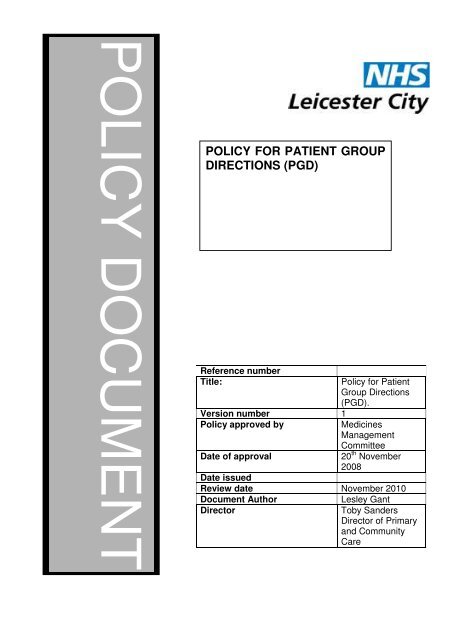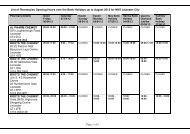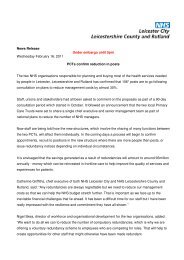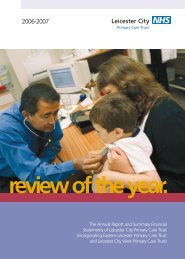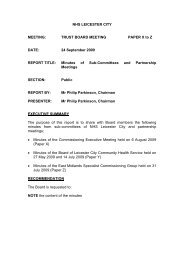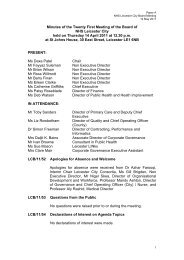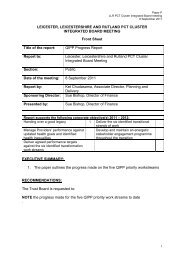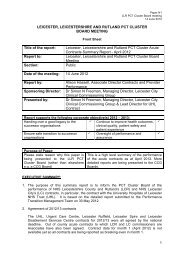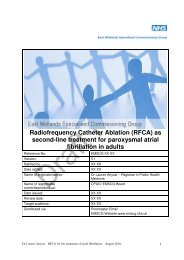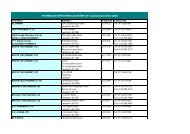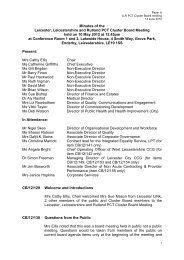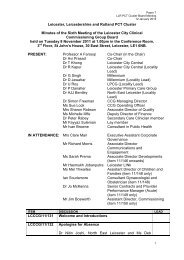POLICY FOR PATIENT GROUP DIRECTIONS (PGD) - NHS
POLICY FOR PATIENT GROUP DIRECTIONS (PGD) - NHS
POLICY FOR PATIENT GROUP DIRECTIONS (PGD) - NHS
You also want an ePaper? Increase the reach of your titles
YUMPU automatically turns print PDFs into web optimized ePapers that Google loves.
<strong>POLICY</strong> DOCUMENT<strong>POLICY</strong> <strong>FOR</strong> <strong>PATIENT</strong> <strong>GROUP</strong><strong>DIRECTIONS</strong> (<strong>PGD</strong>)Reference numberTitle:Version number 1Policy approved byDate of approvalPolicy for PatientGroup Directions(<strong>PGD</strong>).MedicinesManagementCommittee20 th November2008Date issuedReview date November 2010Document AuthorLesley GantDirectorToby SandersDirector of Primaryand CommunityCare
CONTENT PAGE1. Version Control2. Background3. Policy Statement4. Scope of Policy5. Statutory Requirements6. Roles and Responsibilities6.1 Development Flow Diagram <strong>NHS</strong>LCC and NSHLCCHS6.2 Development Process6.2.1 Assessment of Clinical Need for <strong>PGD</strong>6.2.2 Consultation Group6.2.3 Pharmaceutical and Legal Check6.2.4 Submission to Relevant Committees6.2.5 Medicines Management Committee6.2.6 Final Sign Off6.3 Supply and Storage of Medicines6.4 Patient Supply and Administration6.5 Consultation Records6.6 Risk Management7. Format of <strong>PGD</strong> Document8. Training Requirements9. Independent Contractors10. Monitoring and Audit Requirements11. References12. Appendices12.1 <strong>PGD</strong> Template12.2 Competency Assessment Template13. Impact Assessment
2. Background2.1. In 1997, the DH commissioned a Review of the Prescribing, Supply andAdministration of Medicines. The Review Group, chaired by Dr June Crown CBEsubmitted its final report to the Secretary of State for Health in March 1999. Thefirst report of the Review Group concerning the supply and administration ofmedicines by Group Protocol was published in April 1998. Recommendations fromthis report were circulated by the <strong>NHS</strong> Executive in the Health Services Circular(HSC 1998/051): Report on the Supply of Medicines under Group Protocols.2.2. On 9 th August 2000 new legislation on the supply and administration of medicinescame into effect. The legislation authorises the supply and/or administration ofmedicines, where the medicine is supplied for the purpose of being administered oris administered, in accordance with a Patient Group Direction (HSC/2000/026).2.3. Patient Group Directions (<strong>PGD</strong>s), in existence since August 2000, constitute a legalframework which allows certain health care professionals to supply and administermedicines to groups of patients that fit the criteria laid out in the <strong>PGD</strong> without theneed for a prescription or an instruction from the prescriber2.4. This policy has been developed to ensure that <strong>NHS</strong> Leicester City complies withthe legal requirements of HSC 2000/026, 9 August 2000, Patient Group Directions(England Only).2.5. A Patient Group Direction (<strong>PGD</strong>) is a specific written instruction for the supply oradministration of a named medicine in an identified clinical situation. The <strong>PGD</strong>should be locally developed by doctors, pharmacists and other appropriateprofessionals, and approved by the employer, advised by the relevant professionaladvisory committees.2.6. The majority of clinical care should be provided on an individual, patient specificbasis. The supply and administration of medicines under patient group directionsshould be reserved for those limited situations where this offers an advantage forpatient care (without compromising patient safety), and where it is consistent withappropriate professional relationships and accountability. An example of this is theprovision of immunisations and vaccinations3. Policy statementThis policy aims to deliver the following:3.1 Define a consistent, safe and effective process to develop, implement and reviewPatient Group Directions within the law.3.2 Define a method of joint working to reduce duplication of work.3.3 Define health professional responsibility with respect to their role to develop andimplement Patient Group Directions.3.4 Define the responsibility of health professionals with respect to their role to supplyand administer under Patient Group Directions.Policy for the development of Patient Group Directions (<strong>PGD</strong>)Page 4 of 23
4. Scope of the PolicyThis policy applies to:4.1 All qualified health professionals and directorates within <strong>NHS</strong> Leicester City(<strong>NHS</strong>LC) and/or Leicester City Community Health Services (LCCHS) who wish todevelop Patient Group Directions for use in their own area of work.4.2 All qualified health professionals who wish to supply or administer medicines undera Patient Group Direction in <strong>NHS</strong>LC and/ or LCCHS.4.3 Managers, Medicines Management Committee and Clinical Governance Leads whoare responsible for approval of the use of a Patient Group Direction in <strong>NHS</strong>LC and/or LCCHS.4.4 All qualified health professionals who are entitled to act under Patient GroupDirections.4.5 Health professionals can only act within the Patient Group Direction as namedindividuals and must act within their appropriate Code of Professional Conduct.5. Statutory Requirements5.1. HSC 2000/026 clarifies the legal position with respect to the use of “group protocols”recommended in the Report on the Supply and Administration of Medicines underGroup Protocols.5.2. The legal term for these protocols is Patient Group Directions (<strong>PGD</strong>).5.3. A Patient Group Direction is a written instruction to supply and or administer amedicine to groups of patients who may not be individually identified beforepresentation for treatment.5.4. A Patient Group Direction must be signed by a Senior Doctor, a senior pharmacistand a senior nurse and be authorised for use by the PCT5.5. Qualified health professionals who are entitled to act under Patient Group Directionsinclude nurses, midwives, health visitors, optometrists, pharmacists, chiropodists,radiographers, orthoptists, physiotherapists and ambulance paramedics. They canonly do so as named individuals.5.5.1. Pharmacists5.5.2. Registered nurses5.5.3. Registered health visitors5.5.4. Registered midwives5.5.5. Registered dieticians5.5.6. Registered physiotherapists5.5.7. Registered occupational therapists5.5.8. Registered speech & language therapists5.5.9. Registered optometristsPolicy for the development of Patient Group Directions (<strong>PGD</strong>)Page 5 of 23
5.5.10. Registered orthoptists5.5.11. Registered orthoptists and prosthetists5.5.12. State registered chiropodists (podiatrists)5.5.13. State registered physiotherapists5.5.14. State registered radiographers5.5.15. State registered paramedics or qualified ambulance paramedics5.6. Legislation specifies that each <strong>PGD</strong> must contain the following information:5.6.1. The name of the business to which the <strong>PGD</strong> applies.5.6.2. The date the direction comes into force and the date it expires.5.6.3. A description of the medicines to which the <strong>PGD</strong> applies.5.6.4. The class of health professional who may supply or administer the medicine.5.6.5. Signature of a doctor, dentist, nurse where appropriate and a pharmacist.5.6.6. Signature by an appropriate health organisation i.e. PCT, GP practices.5.6.7. The clinical condition or situation to which the <strong>PGD</strong> applies.5.6.8. A description of those patients excluded from treatment under the <strong>PGD</strong>.5.6.9. A description of the circumstances in which further advice should be sought from adoctor (or dentist) and arrangement for referral.5.6.10. Details of appropriate dosage and maximum total dosage, quantity,pharmaceutical form and strength, route and frequency of administration and aminimum and maximum period over which the medicine should be administered.5.6.11. Relevant warnings, including potential adverse reactions.5.6.12. Details of any necessary follow-up action and circumstances.5.6.13. A statement of the records to be kept for audit purposes.Policy for the development of Patient Group Directions (<strong>PGD</strong>)Page 6 of 23
6. Roles and Responsibilities6.1. Development Process Flow diagram for <strong>NHS</strong>LC and <strong>NHS</strong>LCCHSNeed for <strong>PGD</strong> identified within a serviceDiscussion with Medicines ManagementPharmacist (<strong>NHS</strong>LC or LCCHS)Service writes <strong>PGD</strong> (with input from doctor(s)and other healthcare professionals)1-2 months<strong>PGD</strong> distributed to Clinicaland Quality AssuranceDirectorate for commentDiscussionFor all LCCHS services, <strong>PGD</strong> presented toLCCHS Clinical Governance CommitteeLegal and Pharmaceutical check of <strong>PGD</strong> byMedicines Management Team (<strong>NHS</strong>LC)<strong>PGD</strong> signed off by senior professional leads(Doctor, Nurse and Pharmacist, <strong>NHS</strong>LC)Formal review byservice1-2 months 1-2 months<strong>PGD</strong> presented to Medicines ManagementCommittee for organisation approval.<strong>PGD</strong> IS LEGAL TO USE FROM THIS POINTChange in practice impacting on <strong>PGD</strong> or <strong>PGD</strong>expires (<strong>PGD</strong> expires in 2 years from date ofapproval so <strong>PGD</strong> should be reviewed by theservice at least 3 months prior to expiry)Key:= Responsibility of <strong>NHS</strong>LC or LCCHS service= Responsibility of Medicines Management Team/Committee= Direction of work flow/discussionPolicy for the development of Patient Group Directions (<strong>PGD</strong>)Page 7 of 23
6.2. Development Process steps6.2.1. Assessment of clinical need for a <strong>PGD</strong>The following information is essential reading to help answer thequestions below.6.2.1.1. To <strong>PGD</strong> or not to <strong>PGD</strong>? – That is the question. Pharmacy CommunityCare Liaison Grouphttp://129.11.239.213/protocols/<strong>PGD</strong>%20flowchart%202xA4v2.doc6.2.1.2. NPC Patient Group Directions: A guide to good practice.http://www.npc.co.uk/pdf/pgd.pdf6.2.1.3. The individual manufacturers Summary of Product Characteristics(SPC), available on-line at http://www.medicines.org.uk/6.2.1.4. The service wishing to produce a <strong>PGD</strong> must answer the followingquestions and document supporting evidence for the clinical need of a<strong>PGD</strong>.6.2.1.5. Is a <strong>PGD</strong> the most appropriate method of providing treatment for thegroup of patients in the defined clinical situation?6.2.1.5.1. Is there a clearly defined gap in service that a <strong>PGD</strong> can address withoutcompromising patient safety?6.2.1.6. Is the recommended use included in the <strong>PGD</strong> consistent with theSummary of Product Characteristics (SPC) and NICE and locally agreedguidance where available? If not then the <strong>PGD</strong> may not be a feasibleoption6.2.1.7. How will supplies be obtained?6.2.1.8. Is there a safe storage area for medicines?6.2.2. <strong>PGD</strong> discussion groupA service wishing to develop a <strong>PGD</strong> is responsible for organising theappropriate discussion group, which should involve the followingpersonnel6.2.2.1. A senior doctor6.2.2.2. A senior pharmacist6.2.2.3. A representative of the professional group expected to operate withinthe <strong>PGD</strong>.6.2.2.4. Consultation with key stakeholdersPolicy for the development of Patient Group Directions (<strong>PGD</strong>)Page 8 of 23
6.2.3. Pharmaceutical and legal checkThe completed draft <strong>PGD</strong> should be forwarded to a MedicinesManagement Pharmacist for a pharmaceutical and legal check. TheMedicines Management team is responsible for the final legal andpharmaceutical check of the <strong>PGD</strong> before approval and implementation6.2.4. Submission to relevant CommitteesThe draft <strong>PGD</strong> should be submitted to the following committees forcomment and approval6.2.4.1. Relevant clinical groups6.2.4.2. Medicines management Committee6.2.4.3. Clinical Governance Committee (LCCHS)6.2.4.4. Commissioning and governance committee6.2.5. Medicines Management Committee6.2.5.1. The draft <strong>PGD</strong> will be discussed and approved atMedicines Management Committee.6.2.5.2. The Medicine Management committee meets once amonth.6.2.5.3. Contact a member of the Medicines Management teamfor dates and inclusion on the agenda6.2.6. Final sign off6.2.6.1. The <strong>PGD</strong> must be signed by the senior doctor, the seniorpharmacist, senior nurse and the representative of theprofessional group/organisation involved in developingthe direction.6.2.6.2. From this point the <strong>PGD</strong> is a legal document6.3. Supply and storage of medicationThe following should be in place for the <strong>PGD</strong>6.3.1. Arrangements for the security, storage and labelling of all medicinesmust be robust.6.3.2. Medicines for supply for patients to take away should be available inpre-packs made up by a pharmacy.6.3.3. The EC labelling and Leaflet Directive applies to all medicinessupplied under the Patent Group Direction.6.3.4. A patient information leaflet must always be supplied6.3.5. There must be a secure system to record and monitor medicines useso that it is possible to reconcile incoming and out-going stock on apatient by patient basis.6.4. Patient supply and administrationThe service developing the <strong>PGD</strong> is responsible to ensure that supply andadministration of medicines by <strong>PGD</strong> is:6.4.1. Within the law HSC2000/026Policy for the development of Patient Group Directions (<strong>PGD</strong>)Page 9 of 23
6.4.2. Is the most appropriate method of providing treatment for the group ofpatients in the defined clinical situation? (Assessment of the Clinical needfor a <strong>PGD</strong>)6.4.3. Includes the provision of Patient information leaflets (PILS) and additionalspecific information6.5. Record of consultation6.5.1. Robust recording and monitoring procedures must be in place to providea clear audit trail to allow identification of the following:6.5.1.1. Training and competency of staff skills including review (Kept by theManager of the relevant service)6.5.1.2. The health professional administering treatment.6.5.1.3. Patient treated.6.5.1.4. Treatment provided (must include batch number.)6.5.1.5. Appropriate records/ systems in place to easily identify patients andtheir notes for audit purposes6.5.1.6. Records of training / competency assessment/ sign off6.6. Risk ManagementThe following areas of risk must be considered when developing a <strong>PGD</strong>6.6.1. Chaperoning guidelines6.6.2. Consent procedures6.6.3. Complaints, Incidents and Serious Adverse Events reporting protocol (inline with PCT Incident Reporting Process)6.6.4. Significant event auditing6.6.5. Infection control and sterilisation guidelines for primary care6.6.6. Confidentiality of patient data, adherence to Caldicott principles (1999)and data Protection Act (1998)6.6.7. Research Alliance approval for research activity6.6.8. Safeguarding Children procedures and guidelines6.6.9. Safeguarding Adult procedures and guidelines7. Format of a <strong>PGD</strong>The format of the <strong>PGD</strong> must follow the template shown in appendix 1, whichcomplies with legal documents that guide practice (HSC2000/026) and corporaterequirements.8. Training requirements8.1. Clearly defined criteria for implementation, training and competencyassessment must be produced to include:8.1.1. The Law relating to <strong>PGD</strong>s8.1.2. Professional accountability and code of conduct relevant to each healthcareprofession8.1.3. Directions for use8.1.4. Differential diagnosis/patient assessment8.1.5. Dosages and frequency8.1.6. Contra-indications8.1.7. Interactions8.1.8. Side effectsPolicy for the development of Patient Group Directions (<strong>PGD</strong>)Page 10 of 23
8.1.9. Patient advice8.1.10 National and local guidance8.1.11 Position of direction in relation to patient’s total care plan8.1.12 Specific training requirements8.1.13 Any additional requirements for the product8.2 All staff must acknowledge that the interests and safety of every patient isparamount.8.3 The role of the health professional in the use of Patient Group Directions is notcompulsory.8.4 Healthcare professionals have the ability to exercise personal and professionaljudgment as to whether to accept the responsibility that this role will place onthem.8.5 The health professional is responsible for ensuring that they are trained,confident and competent to operate under each <strong>PGD</strong> and for the patients towhich the <strong>PGD</strong> applies.8.6 Staff using a <strong>PGD</strong> must be competency assessed and signed off before usingthe<strong>PGD</strong>8.7 Competency assessment can be in the form of:8.7.10 Role play,8.7.11 Multiple choice questions (MCQ,)8.7.12 Supervised practice8.8 The preferred method of competency assessment is supervised practice.8.9 Where supervised practice is not possible, the following methods should beconsidered:8.9.10 Role play between healthcare professional and assessor;8.9.11 Written test.8.10 Before a healthcare professional can use a <strong>PGD</strong>, they must be individually listedand have signed the individual authorisation form attached to the end of each<strong>PGD</strong>.8.11 Sign off is done after the healthcare professional has been deemed competentfollowing training and assessment.8.12 The clinical lead for a service is responsible for ensuring that all their staff havehad a competency assessment and have been signed off on the individualauthorisation form for each <strong>PGD</strong> before healthcare professionals attempt to useit.8.13 The competency assessment must be documented and must occur at least everytwo years (in line with renewal of <strong>PGD</strong>).Policy for the development of Patient Group Directions (<strong>PGD</strong>)Page 11 of 23
8.14 The content of competency assessment is vital. The competency assessmentmust cover all the relevant areas of the drug (e.g. dose, side effects, andinteractions) and disease (e.g. pathology, differential diagnosis) which the <strong>PGD</strong> iscovering.8.15 The <strong>PGD</strong> Competency Assessment Document in Appendix 3 has been designedto provide services with an outline of what needs to be covered in thecompetency assessment. Services should use the template to add in questionsrelevant to the drug and disease that the <strong>PGD</strong> is covering.9. Independent contractors9.1 Contractors wishing to use a <strong>PGD</strong> approved and adopted by the PCT in theirown practice may do so9.2 The <strong>PGD</strong> should be formally adopted and signed by their organisation.9.3 Independent contractors adopting PCT <strong>PGD</strong>s should ensure adequatetraining and monitoring is completed and documented10. Monitoring and audit requirements10.1 Criteria for audit of <strong>PGD</strong>10.1.1.1 <strong>PGD</strong> is in date10.1.1.2 <strong>PGD</strong> available on premises10.1.1.3 All patients are in inclusion criteria10.1.1.4 Supply / administration of medication to patients in exclusion criteria10.1.1.5 Numbers of patients excluded10.1.1.6 Appropriate advice is given to patients10.1.1.7 Appropriate records are kept10.1.1.8 Medication is appropriately labelled10.1.1.9 Staff appropriately qualified and trainedPolicy for the development of Patient Group Directions (<strong>PGD</strong>)Page 12 of 23
11. ReferencesHSC 2000/026, 9thAugust 2000 Patient Group Directions (England Only).Department of Health Report on the Supply and Administration of Medicines underPatient Group Directions “Crown Report” April 1998.Department of Health (DoH), (1999). Review of Prescribing, Supply andAdministration of Medicines, Final Report. Department of Health. London.Department of Health (DoH), (2000). Patient Group Directions (England only), HSC2000/26 <strong>NHS</strong> Executive, London.Department of Health (DoH), (2001). Reference Guide to Consent for Examination orTreatment, DoH, London.To <strong>PGD</strong> or not to <strong>PGD</strong>? – That is the question. Pharmacy Community Care LiaisonGroup (http://129.11.239.213/protocols/<strong>PGD</strong>%20flowchart%202xA4v2.doc).British National Formulary (BNF), current edition. British Medical Association, RoyalPharmaceutical Society of Great Britain. London.NPC Patient Group Directions: A guide to goodpractice.http://www.npc.co.uk/pdf/pgd.pdfThe individual manufacturers Summary of Product Characteristics (SPC), availableon-line at http://www.medicines.org.uk/For nurses:Nursing and Midwifery Council (NMC), (2004). Code of Professional Conduct:standards for conduct performance and ethics (Ref: Standards 07.04) NMC. London.Nursing and Midwifery Council (NMC), (2007). Standards for Medicines Management(2007)NMC, London.For Pharmacists:Royal Pharmaceutical Society of Great Britain (RPSGB) 1st August 2007. Code ofethics for Pharmacists and Pharmacy Technicians.Royal Pharmaceutical Society of Great Britain (RPSGB) 1st August 2007.Professional Standards and Guidance documentPolicy for the development of Patient Group Directions (<strong>PGD</strong>)Page 13 of 23
Appendix 12.1TEMPLATE<strong>PATIENT</strong> <strong>GROUP</strong> DIRECTIONReference number:Title:Patient Group DirectionVersion number:Policy Approvedby:Date of Approval:Date Issued:Review Date:Document Author:VersionMedicinesCommitteeManagementDirector: Mandy Ashton, Director ofQuality
<strong>PATIENT</strong><strong>GROUP</strong>DIRECTION(<strong>PGD</strong>)(<strong>PGD</strong>)[NAME OF DRUG] <strong>FOR</strong> [CLINICAL CONDITION BEING MANAGED]POM/P/GSL<strong>FOR</strong> USE BY [BODY OF HEALTHCARE PROFESSIONALS] EMPLOYED BY/WORKING ONBEHALF OF [NAME OF SERVICE]Equality Impact Assessment ToolTo be completed and attached to any procedural document when submitted to the appropriatecommittee for consideration and approval.1. Does the policy/guidance affect onegroup less or more favourably thananother on the basis of:• Race• Ethnic origins (including gypsies andtravellers)• Nationality• Gender• Culture• Religion or belief• Sexual orientation including lesbian,gay and bisexual people• Age2. Is there any evidence that some groupsare affected differently?3. If you have identified potentialdiscrimination, are any exceptionsvalid, legal and/or justifiable?4. Is the impact of the policy/guidancelikely to be negative?5. If so can the impact be avoided?6. What alternatives are there to achievingthe policy/guidance without the impact?7. Can we reduce the impact by takingdifferent action?Yes/NoCommentsIf you have identified a potential discriminatory impact of this procedural document, please refer it tothe Policy Administrator, together with any suggestions as to the action required to avoid/reduce thisimpact.For advice in respect of answering the above questions, please contact the Policy Administrator.Date approved:Review date:Ref : Page 2 of 23
<strong>PATIENT</strong><strong>GROUP</strong>DIRECTION(<strong>PGD</strong>)(<strong>PGD</strong>)[NAME OF DRUG] <strong>FOR</strong> [CLINICAL CONDITION BEING MANAGED]POM/P/GSL<strong>FOR</strong> USE BY [BODY OF HEALTHCARE PROFESSIONALS] EMPLOYED BY/WORKING ONBEHALF OF [NAME OF SERVICE]YOU MUST BE AUTHORISED BY NAME, UNDER THE CURRENT VERSION OF THIS <strong>PGD</strong> BE<strong>FOR</strong>EYOU ATTEMPT TO WORK ACCORDING TO ITClinical ConditionDescribe condition/symptoms/presentationDEFINITION OFCONDITION/ SITUATIONInclusion criteria • Condition/situation where treatment under this direction ispermitted• Define age range• Define diagnostic criteria/outcomes of tests required (whereappropriate)• Ensure fits with local guidelines / protocols if appropriateExclusion criteria • Defined upper and lower age limit• Contra-indications listed in the Summary of ProductCharacteristics• Pregnancy (unless totally safe or appropriate for caution)• Breastfeeding (unless totally safe or appropriate for caution)• Known hypersensitivity to (drug name) or any other ingredient inthe product• List all major interactions which would be exclusions• Consider its use in patients with varying degree of renal/hepaticinsufficiency• Situations which are exclusions in local guidelinesCautionsCircumstances when further advice should be sought from a doctor(seek further advice fromsupervising doctor)Action if patient declinestreatment or is excluded1.1.1.1.1 As per local referral guidelinesDescribe what documentation is required and where this should bewritten.Date approved:Review date:Ref : Page 3 of 23
<strong>PATIENT</strong><strong>GROUP</strong>DIRECTION(<strong>PGD</strong>)(<strong>PGD</strong>)[NAME OF DRUG] <strong>FOR</strong> [CLINICAL CONDITION BEING MANAGED]POM/P/GSL<strong>FOR</strong> USE BY [BODY OF HEALTHCARE PROFESSIONALS] EMPLOYED BY/WORKING ONBEHALF OF [NAME OF SERVICE]Description of TreatmentName, form & strength ofmedicine(s)Route/MethodadministrationofDosage & frequency(including maximum totaldose where necessary)Duration of treatmentMaximum or minimumtreatment periodQuantitytosupply/administerSPECIAL PRECAUTIONS<strong>FOR</strong> HANDLING,LABELLING ANDSTORAGE.SIDE EFFECTSe.g. oral, sub-cutaneous, intra-muscular.specify any reconsitution requirements before adninistrationFor antibiotics specify coursee.g. storage in refrigerator ,• List side effects as described in the Summary of ProductCharacteristics/British National Formulary.• List side effects in order with the most commonly occurringones first• Use the Yellow Card System to report adverse drug reactions(ADR’s) directly to the Commission on Human Medicines.Guidance on the use of the Yellow Card System and YellowCards are available in the current BNF. Report all significantADR’s to patients’ own GP.Advice to patient/carer • Advise patient on how to take the medication (e.g. takewith/after food, avoid grapefruit juice, complete the courseetc…)• Counsel patient on the potential side effects• Advise to patient on how to manage these side effects (whereappropriate)• What to do if condition/symptoms do not improve/worsen• Give a patient information leafletFollow up • Follow up with another health care professional (e.g.GP)• Specify timeframe for follow-upReferral arrangements • Circumstances for further adviceDate approved:Review date:Ref : Page 4 of 23
<strong>PATIENT</strong><strong>GROUP</strong>DIRECTION(<strong>PGD</strong>)(<strong>PGD</strong>)[NAME OF DRUG] <strong>FOR</strong> [CLINICAL CONDITION BEING MANAGED]POM/P/GSL<strong>FOR</strong> USE BY [BODY OF HEALTHCARE PROFESSIONALS] EMPLOYED BY/WORKING ONBEHALF OF [NAME OF SERVICE]Records and AuditRecords • Patient’s name, address, date of birth and consent given• Contact details of GP (if registered)• Diagnosis• Name of drug, dose and form given/administered• Batch and expiry date details• Advice given to patient (including side effects)• Signature/name of staff who administered or supplied themedication, and also, if relevant, signature/name of staff whoremoved/discontinued the treatment• Details of any adverse drug reaction and actions taken includingdocumentation in the patient’s medical record• Follow-up arrangementsAudit• Ensure appropriate records/system are in place to easily identifypatients and their notes for audit purposes.An audit should be conducted at least annually by services to ensurethat they are complying with the requirements of this <strong>PGD</strong>.Staff CharacteristicsQUALIFICATIONSRegistered professional [appropriate qualification to be listed] with acurrent [professional] registrationSPECIALISTCOMPETENCIESQUALIFICATIONSORCONTINUING TRAINING &EDUCATIONThe practitioner should be aware of any change to therecommendations for the medicine listed. It is the responsibility of theindividual to keep up-to-date with continued professionaldevelopment.References/Resources andcommentsBritish National FormularySummary of Product CharacteristicsAny local or national guidelines (e.g. NICE, Clinical KnowledgeSummaries)Date approved:Review date:Ref : Page 5 of 23
<strong>PATIENT</strong><strong>GROUP</strong>DIRECTION(<strong>PGD</strong>)(<strong>PGD</strong>)[NAME OF DRUG] <strong>FOR</strong> [CLINICAL CONDITION BEING MANAGED]POM/P/GSL<strong>FOR</strong> USE BY [BODY OF HEALTHCARE PROFESSIONALS] EMPLOYED BY/WORKING ONBEHALF OF [NAME OF SERVICE]This patient group direction must be agreed to and signed by all health care professionals involved inits use. The <strong>NHS</strong> Trust should hold the original signed copy. The <strong>PGD</strong> must be easily accessible inthe clinical setting1.1.1.2 Name ofAuthor1.1.1.3 Directorateresponsible forreviewing1.1.1.4 Organisation <strong>NHS</strong> Leicester CityAuthorisationLEAD DOCTORNAME: AZHAR FAROOQIPosition: Professional Executive Committee ChairSignature:Date:LEAD NURSE/ALLIEDHEALTH PROFESSIONALNAME: MANDY ASHTONPosition: Director of Quality /Deputy Chief ExecutiveSignature:Date:LEAD PHARMACISTNAME: SUSANNA TAYLORPosition: Assistant Director Medicines Management<strong>PGD</strong> reviewed bySignature:Date:Patient Group Direction Peer Reviewed by1.1.1.51.1.1.6 Name1.1.1.71.1.1.81.1.1.91.1.1.101.1.1.11POSITIONDATEDate approved:Review date:Ref : Page 6 of 23
INDIVIDUAL AUTHORISATION<strong>PGD</strong>s DO NOT REMOVE INHERENT PROFESSIONAL OBLIGATIONS OR ACCOUNTABILITY.It is the responsibility of each professional to practice only within the bounds of their owncompetence and in accordance with their own Code of Professional Conduct.Note to Authorising Managers: authorised staff should be provided with an individual copy of theclinical content of the <strong>PGD</strong> and a photocopy of the document showing their authorisation.Healthcare Professional’s Declaration:I have read and understood the Patient Group Direction and agree to supply/administer thismedicine only in accordance with this <strong>PGD</strong>.Authorising Manager’s Declaration:I have assessed the knowledge and competencies of the healthcare professionals listed below inaccordance with the requirements of the <strong>PGD</strong>.Name of Health CareProfessionalSignature of HealthCare ProfessionalAuthorisingManager’s SignatureDate
Appendix 12.2 Competency Assessment Document – (insert name of <strong>PGD</strong> here)Name of HCP Line ManagerJob Title DateKnowledge/Competency beingassessedUnderstanding of general principalsof <strong>PGD</strong> use and legalitiesQuestions/Statement to assess knowledge/competencyExamples of suitable questions:• A black-triangle drug can be put on a <strong>PGD</strong>• Unlicensed medicines can be put on a <strong>PGD</strong>• A <strong>PGD</strong> needs to be signed only by a doctor for it to be legal• A <strong>PGD</strong> needs to be reviewed yearly• HCPs must be competency assessed for each <strong>PGD</strong> before theycan use it• A <strong>PGD</strong> can only be used by independent prescribersKnowledge/competencyshown? (or HCP to answer“True” or “False” if written testRelevant trainingExamples of suitable questions:• Is the HCP up-to-date with CPR training?• Is the HCP up-to-date with anaphylaxis training?Understanding of disease orcondition to be managed by the<strong>PGD</strong>Insert questions to test HCP’s understanding of:• Disease/condition• Disease progression• Differential diagnosis• Danger/warning signs
Knowledge/Competency beingassessedUnderstanding of drug contained inthe <strong>PGD</strong>Questions/Statement to assess knowledge/competencyInsert questions to test HCP’s understanding of:• mechanism of action of drug• dose• side effects• interactions• cautions• Contra-indicationsKnowledge/competencyshown? (or HCP to answer“True” or “False” if written testUnderstanding of specific <strong>PGD</strong>Insert questions to test HCP’s understanding of::• inclusion criteria• exclusion criteria• when to refer• advice to give• documentationFinal Mark: ……………………..
To be used by the assessor onlyList below actins taken where a gap in the HCP’s knowledge/competency has been identified:Gap in Knowledge/CompetencyAction(s) taken (e.g. discussion, reading etc.)Name of Assessor:Job Title:Date:


